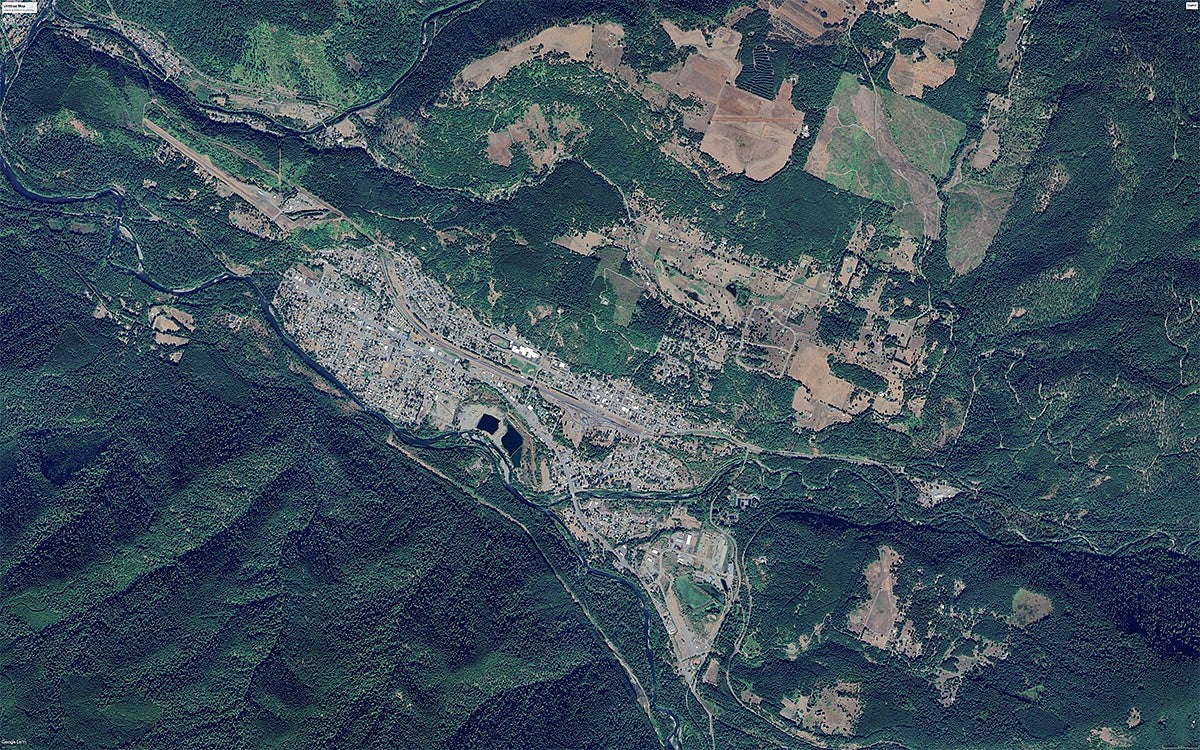Background
The City of Oakridge and community stakeholders have worked together over the past two decades to improve air quality and meet the fine particulate National Ambient Air Quality Standards (NAAQS) under the federal Clean Air Act. Oakridge-Westfir is a "mile-wide valley along the middle fork of the Willamette Valley, [that] has been a "nonattainment area" for particulate matter since 1987, meaning it did not meet the federal health-based Clean Air Act standard for that pollutant." Learn more from the EPA.

Oakridge, in Lane County, Oregon, has historically been ranked among the top 20 communities in the United States with the worst air quality due to high concentrations of particulate matter (PM2.5) from home wood heating (woodstove) and wildfire smoke. Due to the steep topography of the area and Oarkridge's location in a basin-shaped valley bottom, the community is prone to atmospheric inversions that trap seasonal wildfire smoke and wintertime home heating woodsmoke in the community.
Led by EWP, the UO research team also included partners from the Institute for Policy Research and Engagement, the Center for Science Communication Research within the School of Journalism and Communication, and the Department of Physics. As community-informed research, the UO team also worked closely with Oakridge Air and their partners, including the Southern Willamette Forest Collaborative, South Willamette Solutions, Lane Regional Air Protection Agency and Good Company.
Funding
This research was funded through:
- The Lane Regional Air Protection Agency as part of the Environmental Protection Agency 2021 Targeted Airshed Program (TAG2), under intergovernmental agreement number LARAPA 22-05-01TAG2
- University of Oregon funding through the Ecosystem Workforce Program
Oakridge-Westfir Community Survey
In 2023, we conducted a survey in partnership with Oakridge Air, on air quality and smoke from wildfire and woodstoves. This community survey was informed by interviews conducted with community leaders to identify key information needs and actions related to these topics. The survey aimed to document Oakridge-Westfir residents' concerns about their local air quality, perspectives and responses to recent wildfire smoke, and their preferences and interests in air quality communications and other Oakridge Air programs.
Final Survey Results and Supporting Materials (2024)
Working Paper 119, Oakridge-Westfir Smoke and Air Quality: Community Survey
Appendix I: Survey Questions, Consent Form, Gift Card Form, and Survey Hand-Out

Localized Air Quality Data
Purple Air (PA) is a type of low-cost PM 2.5 sensor that can be used to monitor indoor air quality. Oakridge Air led recruitment for signing up households who were participants in their home heating upgrades program (which focused on exchanging old or uncertified woodstoves to new, efficient models) to also sign up for PA sensor installs to evaluate effectiveness of these interventions to improve indoor air quality. Over the course of the project, EWP provided support for sensor installations, data collection, and curation protocols; and partnered with the Department of Physics, for statistical data analysis. Preliminary results are reported in the poster.
Air Quality Analysis: Preliminary Results (2024)
Communication Audit: Oakridge Air
Oakridge Air serves the communities of Oakridge-Westfir and promotes healthy air quality through individual and community resources.
Oakridge Air, which is funded by the Environmental Protection Agency, has five program areas:
- Home heating upgrades
- Community Firewood
- School Education
- Cleaner Indoor Air
- Code Enforcement
Oakridge Air uses several communication strategies to engage community members in these programs. This audit provides an overview of Oakridge Air's communication and messaging strategy, focusing on messaging from 2021-2022, to provide strategic communication recommendations for future work. This audit focuses primarily on the Oakridge Air Communication Plan and messaging templates, community newsletters, text messaging service, Oakridge Air's Facebook page, and Oakridge Air's website.
Final Report (2023)
Cedar Creek Fire: After Action Review
At the request of Oakridge Air, EWP and the Center for Science Communication Research helped facilitate an After-Action Review workshop to support community needs in Fall 2022. This report shares community lessons learned during emergency response, timeline for smoke response and evacuation, and future recommendations.
Final Report (2022)
Air Quality and Smoke: Community Leader Interviews
This pilot project focused on learning more about community understanding, experiences, and awareness of air quality and smoke issues in Oakridge-Westfir, as well as to inform the community household survey.
Key findings were grouped into:
- Air quality literacy
- Effective communication sources
- Smoke related air quality concerns and behaviors
- Community preparedness for smoke events
- Awareness of Oakridge Air programs
Final Interview Results and Fact Sheet (2022)
Working Paper 113, Air Quality and Smoke: Pilot Interviews with Key Community Leaders
Fact Sheet: Air Quality and Smoke: Pilot Interviews with Community Leaders
